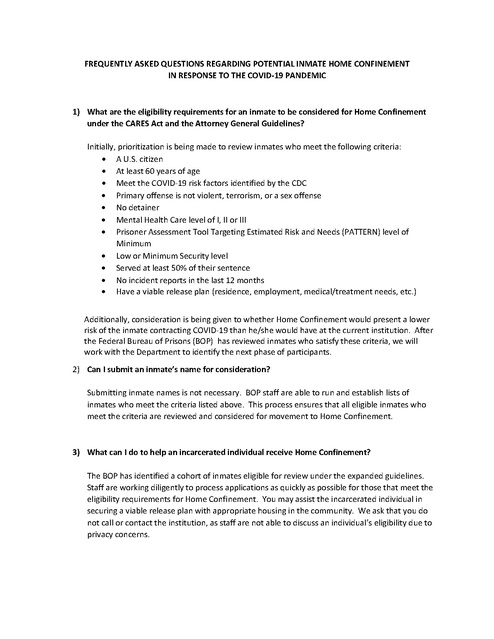COVID-19 Home Confinement FAQ (removed memo from BOP site), BOP, 2020
Download original document:

Document text

Document text
This text is machine-read, and may contain errors. Check the original document to verify accuracy.
FREQUENTLY ASKED QUESTIONS REGARDING POTENTIAL INMATE HOME CONFINEMENT IN RESPONSE TO THE COVID-19 PANDEMIC 1) What are the eligibility requirements for an inmate to be considered for Home Confinement under the CARES Act and the Attorney General Guidelines? Initially, prioritization is being made to review inmates who meet the following criteria: • A U.S. citizen • At least 60 years of age • Meet the COVID-19 risk factors identified by the CDC • Primary offense is not violent, terrorism, or a sex offense • No detainer • Mental Health Care level of I, II or III • Prisoner Assessment Tool Targeting Estimated Risk and Needs (PATTERN) level of Minimum • Low or Minimum Security level • Served at least 50% of their sentence • No incident reports in the last 12 months • Have a viable release plan (residence, employment, medical/treatment needs, etc.) Additionally, consideration is being given to whether Home Confinement would present a lower risk of the inmate contracting COVID-19 than he/she would have at the current institution. After the Federal Bureau of Prisons (BOP) has reviewed inmates who satisfy these criteria, we will work with the Department to identify the next phase of participants. 2) Can I submit an inmate’s name for consideration? Submitting inmate names is not necessary. BOP staff are able to run and establish lists of inmates who meet the criteria listed above. This process ensures that all eligible inmates who meet the criteria are reviewed and considered for movement to Home Confinement. 3) What can I do to help an incarcerated individual receive Home Confinement? The BOP has identified a cohort of inmates eligible for review under the expanded guidelines. Staff are working diligently to process applications as quickly as possible for those that meet the eligibility requirements for Home Confinement. You may assist the incarcerated individual in securing a viable release plan with appropriate housing in the community. We ask that you do not call or contact the institution, as staff are not able to discuss an individual’s eligibility due to privacy concerns. 4) If an incarcerated individual does not qualify for Home Confinement under the CARES Act, is there any other means for them to release from an institution early? All inmates are reviewed for placement in Residential Reentry Centers and Home Confinement near the end of their sentence in accordance with the Second Chance Act and First Step Act. Every effort is being made to review inmates with impending releases dates for placement in Residential Reentry Centers. 5) Can I provide transportation to the approved residence for an individual who has been approved for Home Confinement? Transportation from the institution to the approved residence may be provided by any approved visitor on the inmate’s visitation list. This option is especially important, as public transportation options may currently be limited in many areas. 6) How does this initiative affect people participating in RDAP? Community Treatment Services (CTS) is the third required component of the Residential Drug Abuse Program (RDAP) that inmates must successfully complete in the community to finish RDAP and earn a 3621(e) early release. Inmates can still complete this requirement while on home confinement, as long as they attend required counseling. Inmates who are currently participating in the unit-based component of RDAP must complete this component before they can be placed on home confinement. 7) Is there a quarantine requirement for inmates moved to Home Confinement? In order to protect the public, prior to transfer to home confinement, all inmates must be quarantined at an appropriate BOP facility for 14 days, or, subject to case-by-case discretion, they must be quarantined in the residence where the inmate will be transferred.





